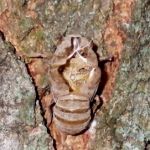Cicadas, just like crickets, are very noisy insects. If you walk around and look at tree trunks in the summer in lots of places in North America you can see weird motionless insects sitting there.

Weird insect sitting on a tree?
Actually it is the exoskeleton of a cicada nymph after the adult insect has crawled out of it.
As it turns out those are not really the insects, only their molted exoskeletons left behind by a brand new adult cicada. It is sometimes difficult to actually see a live specimen while the sound they make can be heard all over the place.

An adult cicada sitting on a fence in Scarborough.
I am not an expert on cicadas, but it is most likely a species of dog-day cicada (Tibicen), probably a Tibicen canicularis.
Cicadas can be very long lived. Some species of periodical cicadas spend as much as 13 or even 17 years living underground as a nymph. Finally the nymph emerges from the ground, climbs up to something, sheds its outer shell and turns into an adult flying cicada. The usual explanation for such a long time spent as larvae before turning into a adult insect is to escape in time from predators. Living underground for a long time and then emerging all at once those species of cicadas play on strength in numbers. There are so many of them that the predators can’t get them all. Because of the long time spent as larvae the predators cannot prey on cicadas each year, so their numbers get depleted by the time the next generation of cicadas emerge. By spending a prime number of years as larvae, periodical cicadas can avoid predators that would adjust the time between their generations to emerge only every couple of years that could be a divisor of the number of years of the cicada life cycle. But because the life cycle of a periodical cicada includes spending some prime number of years as a nymph predators can’t trap them that way — or so goes the theory.

The specimens shown in these pictures are dog-day cicadas that do not have such a long life cycle as periodic cicadas do, and generations are not all that well synchronized thus some of them emerge each year.
Cicadas tend to be large 1-2 inches long and emerge in large numbers. It is no surprise that not only animal predators, but also humans eat them, after all they are a good protein source. I personally never managed to gather enough cicadas to be worth cooking them, but the taste is described as similar to eating shrimp.
Further Readings:
Cicadas on High Park Nature.
How To Catch Cicadas.
How to Catch, Kill, and Cook Cicadas.
Dog-day cicada on Wikipedia.
Annual cicada on Wikipedia.
Periodical cicadas on Wikipedia.


